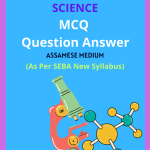Class 7 Science MCQ Chapter 10 Respiration in Organisms Solutions in English Medium, Class 7 Science Multiple Choice Question Answer in English to each chapter is provided in the list so that you can easily browse throughout different chapters Class 7 Science MCQ Chapter 10 Respiration in Organisms Notes and select need one.
Class 7 Science MCQ Chapter 10 Respiration in Organisms
Also, you can read the SCERT book online in these sections Class 7 Science Objective Type Solutions by Expert Teachers as per SCERT (CBSE) Book guidelines. These solutions are part of SCERT All Subject Solutions. Here we have given Assam Class 7 Science MCQs Solutions in English for All Subject, You can practice these here.
Respiration in Organisms
Chapter – 10
| MCQ |
1. Which of the following is not a part of the human respiratory system?
(a) lungs.
(b) Oesophagus.
(c) trachea.
(d) Diaphragm
Ans: (d) Diaphragm.
2. What is the process called when glucose is broken down with the use of oxygen?
(a) Anaerobic respiration.
(b) Cellular respiration.
(c) Aerobic respiration.
(d) Fermentation.
Ans: (c) Aerobic respiration.
3. What happens during anaerobic respiration?
(a) Oxygen is used to break down glucose.
(b) Glucose is broken down without the use of oxygen.
(c) Carbon dioxide is converted into oxygen.
(d) Water is used to produce glucose.
Ans: (b) Glucose is broken down without the use of oxygen.
4. One of the following is not produced during the anaerobic respiration in yeast. This one is:
(a) carbon dioxide.
(b) energy.
(c) lactic acid.
(d) alcohol.
Ans: Lactic acid.
5. Which of the following is not a product of aerobic respiration?
(a) carbon dioxide.
(b) alcohol.
(c) energy.
(d) water.
Ans: (b) Alcohol.
6. Where does the breakdown of glucose occur in an organism?
(a) In the stomach.
(b) In the liver.
(c) In the cells.
(d) In the intestines.
Ans: (c) In the cells.
7. Yeast converts glucose into:
(a) Starch.
(b) Alcohol.
(c) Lactic acid.
(d) Yogurt.
Ans: (b) Alcohol.
8. Which process occurs when there is insufficient oxygen supply to muscle cells during heavy exercise?
(a) Aerobic respiration.
(b) Anaerobic respiration.
(c) Photosynthesis.
(d) Fermentation.
Ans: (b) Anaerobic respiration.
9. During respiration in humans, the exchange of gases takes place in:
(a) Bronchi.
(b) Alveoli.
(c) Bronchioles.
(d) Trachea.
Ans: (b) Alveoli.
10. What is the role of breathing in the respiration process?
(a) To produce glucose.
(b) To exchange gases between the organism and the environment.
(c) To remove excess water from the body.
(d) To regulate body temperature.
Ans: (b) To exchange gases between the organism and the environment.
11. Which of the following does not have lungs for breathing?
(a) lizard.
(b) frog.
(c) fish.
(d) fox.
Ans: (c) Fish.
12. Which of the following is most likely to have a much higher breathing rate?
(a) Man.
(b) Dog.
(c) Sparrow.
(d) Fish.
Ans: (d) Fish
13. How do earthworms perform gas exchange?
(a) Through their gills.
(b) Through their tracheae.
(c) Through their moist skin.
(d) Through their lungs.
Ans: (c) Through their moist skin.
14. The process by which food (glucose) is broken down to release energy is called:
(a) digestion.
(b) photosynthesis.
(c) circulation.
(d) respiration.
Ans: (d) Respiration.
15. The small openings in the body of a cockroach are called?
(a) Holes.
(b) Spiracles.
(c) Tracks.
(d) Pores.
Ans: (b) Spiracles.

Hi! my Name is Parimal Roy. I have completed my Bachelor’s degree in Philosophy (B.A.) from Silapathar General College. Currently, I am working as an HR Manager at Dev Library. It is a website that provides study materials for students from Class 3 to 12, including SCERT and NCERT notes. It also offers resources for BA, B.Com, B.Sc, and Computer Science, along with postgraduate notes. Besides study materials, the website has novels, eBooks, health and finance articles, biographies, quotes, and more.



